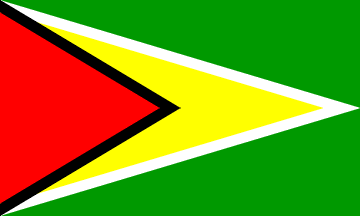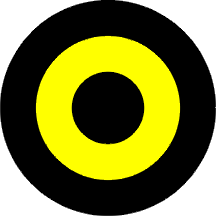
This page is part of © FOTW Flags Of The World website
Guyana
Co-operative Republic of Guyana
Last modified: 2001-11-09 by dov gutterman
Keywords: guyana | america | arrow |
Links: FOTW homepage |
search |
disclaimer and copyright |
write us |
mirrors

by Zeljko Heimer, 27 October 2001
See also:
- Guyana - Presidential Flag
- Guyana - Civil and Naval Ensign
- Guyana - Civil Air Ensign
- Guyana - Political Flags
- Guyana - Historical Flags (2 parts)
The Flag
From: http://www.guyana.org/flag.htm
"The Golden Arrowhead, Guyana's National Flag has FIVE
symbolic colors:
GREEN represents the agricultural and forested nature of
Guyana,
WHITE symbolizes the rivers and water potential of the
country,
GOLDEN arrow represents Guyana's mineral wealth,
BLACK portrays the endurance that will sustain the forward
thrust of the Guyanese people,
RED represents the zeal and dynamic nature of nation-building
which lies before the young and independent Guyana."
Dov Gutterman, 6 January 1999
At July York ICV meeting, showing Guyana page of Album to
Whitney Smith, he told me that my ill 1 (sea version) is wrong,
summit of triangle should reach the middle of flag. ;I have no
illustration of that (any FOTWer ?)
Armand du Payrat, 25 October 2001
According to Album 2000 [pay00]
- National Flag (CSW/--- 3:5) - On lnad the flag is in ratio 3:5,
green with white fimbrated yellow isosceles triangle with base at
hoist and top at fly end, and over it a black fimbrated red
traingle with bas at hoist and top at midpoint of the flag. The
fimbrations are not made along hoist edge, of course.
Apparently, as Armand discovered talking with Whitney Smith, the
hoist trinagle should reach the midpoint of the flag (and should
not be an equilateral triangle).
Zeljko Heimer, 27 October 2001
Although I have no correct construction sheet of the Guyana
flag, I've found an interesting data in Ludvik Mucha's book
"Flags and Coats of Arms". According to him, green
color occupies 50% of the flag area, yellow 24%, red 16%, white
6% and black 4%. However, if the red+black triangle reaches the
center of the flag, red+black should occupy 25% (not 20%), and
yellow+white also 25% (not 30%) of the area.
Jan Zrzavy, 7 November 2001
The Designer
This is probably the only current national flag to be designed
by Whitney Smith and his team!
David Kendall , 1 October 1996
The black and white fimbriations were not in Whitney Smith's
original design, but were added by the English College of Arms.
Can't see why, as the flag wasn't disobeying the
colour-on-colour/metal-on-metal rule before (it does now!).
Roy Stilling, 1 October 1996 and 14 May 1997
I had actually heard that the fimbriations were added by
officials of the Guyanan government.� In either case, Dr.
Smith's original design did not include them.
Steve Kramer, 8 December 2000
The current flag of Guyana was designed in 1962 by an
American, Mr. Whitney Smith, and was the result of an
international competition held by the then government. (The year
1962 was expected to be "Independence Year"). The
design was NEVER CHANGED by the new government which took office
in December 1964. This flag of Guyana, since 1966, became known
as the "Golden Arrowhead."
Amb. Odeen Ishmael, Guyana Embassy - Washington DC, 18
December 2000
In DK's Complete Flags of the World (1999) I read: 'The
original design had a red field, but this was altered by the
College of Arms (in England) in 1966, which also added the black
and white fimbriations.' That is corroborated in Crampton's FOTW
(1990) and by Roy Stilling.
Jarig Bakker, 18 December 2000
Just a clarification: "The original design had a red
field" - I assume it means: 'green triangle on yellow arrow
on red field' and not 'red triangle on yellow arrow on red
field'.
Ole Andersen, 18 December 2000
In Smith's original design, the red and the green altered
their positions. I believe that it was because that those who
participate in a contest want to win the contest. Smith made his
design prevaling the red color according to the leftist
inclinations of the premier Mr. Jagan (a ethnic indian
pro-soviet). The design of Vaclav Kalikova also show a gold
triangle (but single) from hoist to fly and rest is green (and a
blue star is in the yellow triangle). Perhaps the College of arms
made a mixture of both designs. I believe that the five colors
were in fact requested by the government (I read it) but I don't
remember if for Mr. Jagan or Mr. Burham. The fimbriations are
against the heraldic principes and is strange that College of
arms (aleways precise) added unnecesary fimbriations.
Jaume Oll?, 7 January 2001
Coat of Arms
.gif)
by Zeljko Heimer, 28 October 2001
The CoA is mostly unchnaged Corel Clipart image, coloured
according to [smi82].
Zeljko Heimer, 28 October 2001
The coat of arms features the following local attributes:
- a cacique's crown
- diamonds
- jaguars
- agricultural products (sugar cane and rice)
- a pickaxe
- a 'canje' pheasant
The traditional featherhead crown is also present on the President's standard. The national flower
(Victoria regia lily) is also present on this flag.
The arms were granted in 1966, the President's standard in 1970.
Sources: Smith (1976) ; DK Pocket Book (1998).
Ivan Sache, 29 October 2001
Aircraft Marking

by Zeljko Heimer, 27 October 2001
A report from a French vessel visiting the country also told
me that aircraft marking� (b - y - b roundel) is no more valid :
reportedly� it shows now the letters SDF.
Armand du Payrat, 25 October 2001
According to Album 2000 [pay00]
- Aircraft marking - Black-yellow-black roundel. A note says that
the national flag is painted on the fin. Armand suggested that
this markings are currently obsolete.
Zeljko Heimer, 27 October 2001
|